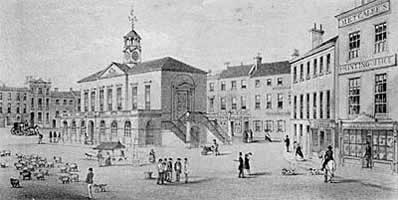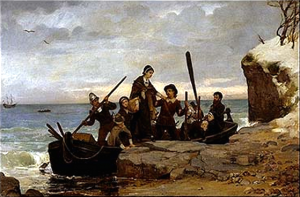Sorry I’ve been so delinquent about continuing our travels through Nottinghamshire. It’s been a busy couple of weeks, what with driving Child1 to college nine hours away, then turning around 24 hours after I got home to make the ten hour round trip to a signing in Portland. I barely got back from that in time to attend Child2’s acting debut, literally walking in just as the play began. And then two days after that, I started running a character workshop for the FF&P Chapter of RWA. Whew!
But things have settled down now, sort of, so we’re off again, backtracking, as Steinarr and Marian did, from Haworth toward Sudwell, stopping off at the Retford market. This is the market where Ari sat in the tavern and spun the story that inadvertently started the rumors about Robin Hood.
Retford, which lies on the River Idle about 30 miles north of Nottingham, has long been the prinicipal market town in an area known as the Hundred* of Bassetlaw. Ret-, or Red- (the town appears in the Domesday Book as Reddeforde), is a reference to a layer of red clay that underlies the ancient crossing point, which used to be stirred up by cattle crossing the shallows (Ari notes that red coloring as he rides in for the Saturday market in Chapter 10). The west side of the river held the first settlement, but townsfolk soon moved across the Idle and East Retford, as it’s still properly called.

The right to hold the weekly market was granted by royal charter from Edward 1 in 1275, an additional boon to the annual fair Henry III had granted Retford in 1246. The market continues today, held in the Market Square. The square also holds the Broad Stone, where, legend has it, coins were disinfected in vinegar during plague times. Across from Market Square is St. Swithun Church and Cannon Square, which holds a cannon reportedly captured during the Siege of Sevastopol at the end of the Crimean War (1846). Unfortunately, although the ancient market still exists, there doesn’t seem to be much else left from  medieval times. Even though St. Swithun as a church dates back to 1258 or earlier, the oldest surviving bit of the building is a 14th c pillar and arches. The rest was rebuilt in the 15th and 17th centuries, and most of the town square (shown in a 1848 print) is Georgian or later.
The area southwest of Retford was known as The Dukeries, for the five ducal seats found there. During the 1700s, four of these ducal parks abutted each other: Clumber House, principal seat of the dukes of Newcastle; Thoresby Hall, principal seat of the dukes of Kingston; Welbeck Abbey: principal seat of the dukes of Portland; and Worksop Manor, a seat of the dukes of Norfolk. The fifth was Bestwood Lodge, a seat of the dukes of St Albans, some 15 miles south.
 The area’s other claim to fame (besides being in the heart of Robin Hood Territory) is that it’s the original home of the Pilgrim Fathers, who came from Scrooby, several miles to the north, and Babworth, a village just a mile or so west of Retford. Those founding Pilgrim Fathers left Bassetlaw in 1607 to start their new life in Holland, and 13 years later, in 1620, in Plymouth. [Fun unrelated factoid: My husband is a direct descendant of Richard Warren, one of the Outsiders (non-Pilgrims hired as planters) in the Mayflower company. Warren was one of ten men in the first landing party along with Miles Standish—he’d  one of those in The Landing of the Pilgrims, by Henry A Bacon, shown here — and was one of the co-signers of the Mayflower Compact and a Governor of the colony. Other Warren descendants include President Ulysses S. Grant, President Franklin D. Roosevelt, Alan Shepard, Laura Ingalls Wilder, Richard Gere, the Wright brothers—and of course, Child1 and Child2.]
The area’s other claim to fame (besides being in the heart of Robin Hood Territory) is that it’s the original home of the Pilgrim Fathers, who came from Scrooby, several miles to the north, and Babworth, a village just a mile or so west of Retford. Those founding Pilgrim Fathers left Bassetlaw in 1607 to start their new life in Holland, and 13 years later, in 1620, in Plymouth. [Fun unrelated factoid: My husband is a direct descendant of Richard Warren, one of the Outsiders (non-Pilgrims hired as planters) in the Mayflower company. Warren was one of ten men in the first landing party along with Miles Standish—he’d  one of those in The Landing of the Pilgrims, by Henry A Bacon, shown here — and was one of the co-signers of the Mayflower Compact and a Governor of the colony. Other Warren descendants include President Ulysses S. Grant, President Franklin D. Roosevelt, Alan Shepard, Laura Ingalls Wilder, Richard Gere, the Wright brothers—and of course, Child1 and Child2.]
More Retford history can be found at the Nottinghamshire Heritage Gateway.
Next: Sudwell
![]()
*A hundred, otherwise known as a wapentake, was an administrative division established by King Aflred (849-899, ruled 871-899) at the same time he created the English shire system. The idea of a hundred comes from Germanic areas (as did the Angles and the Saxons) and was recorded as early as 98 AD. In England, the division was supposed to contain a hundred of something, though accounts vary as to whether that number referred to an area liable for providing a hundred men-at-arms, or containing roughly a hundred homesteads, or to a small parcel (thus loosely a hundredth) of the shire.


Comments are closed, but trackbacks and pingbacks are open.